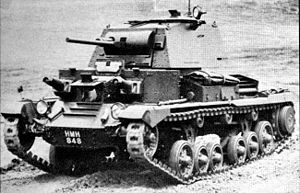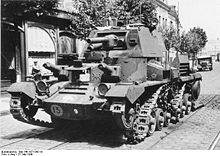- Cruiser Mk I
-
Tank, Cruiser, Mk I (A9) 
Tank, Cruiser, Mk I (A9)Type Cruiser tank Place of origin  United Kingdom
United KingdomService history In service 1938-1941 Used by British Army Wars Second World War Production history Designer Sir John Carden Manufacturer Vickers Produced 1936-1941 Number built 125 Specifications Weight 12 tons Length 19 ft (5.8 m) Width 8 ft 4 in (2.5 m) Height 8 ft 8 in (2.65 m) Crew 6 (Commander, gunner, loader, driver, 2x MG gunners) Armour 6 - 14 mm Main
armamentQF 2-pdr
100 roundsSecondary
armament3 x 0.303 Vickers machine gun
3,000 roundsEngine AEC 179 6 cylinder petrol[1]
150 hpSuspension sprung triple wheel bogie Operational
range150 miles (241 km) Speed 25 mph (40 km/h) The Tank, Cruiser, Mk I (A9) was a British cruiser tank of the interwar period. It was the first cruiser tank: a fast tank designed to bypass the main enemy lines and engage the enemy's lines of communication, along with enemy tanks. The Cruiser Mk II was a heavier armoured adaptation of the Mark I developed at much the same time.
Contents
Design and development
In 1936 the British War Office designated two different kinds of tanks for future development: heavily armoured infantry tanks to be used in close co-operation with infantry during attacks, and fast mobile cruiser tanks designed to make forays deep into enemy territory.
In 1934 Sir John Carden of Vickers-Armstrong had produced a new medium tank, the A9, which was subsequently designated the Cruiser Tank Mark I. It incorporated the best features of the earlier Mk III Light Tank, and was powered by a commercial petrol engine. However, this was still in the time of the Great depression and the tank had a number of cost-cutting measures applied. It was the first British tank to have a centrally-located turret, but was poorly armoured, with a maximum of 14 mm thickness, many armour faces were vertical, and there were numerous shot traps.
The driver's compartment and the fighting compartments were not separated. As well as the turret armament, which consisted of a QF 2-pounder (40 mm) gun and a coaxial Vickers machine gun, there were two small turrets either side of the driver's compartment, each sporting one more machine-gun. Both these smaller turrets were permanently manned, which gave the tank a total crew of 6 (Commander, gunner, loader, driver and two machine-gunners).
The tank entered testing in 1936 and 125 were ordered in the summer of 1937 as an interim design pending the delivery of a Cruiser tank based on the Christie suspension. 75 were built by Harland and Wolff, and the other 50 were built by Vickers. Originally a Rolls-Royce car engine was used, but this proved underpowered and was replaced by an AEC bus engine.
The later Valentine Infantry tank essentially used the same lower hull and suspension, though with considerably more armour.
The A9 weighed 12 tons, was 5.8 metres long, 2.65 metres high, 2.5 metres wide, and had a top speed of 25 mph on road and 15 mph off. Its maximum road range was 150 miles. The ammunition load was 100 2-pounder rounds and a total of 3,000 rounds for the three Vickers machine guns.
Service
 A damaged Cruiser Mk I CS abandoned in Calais, 1940.
A damaged Cruiser Mk I CS abandoned in Calais, 1940.
The Cruiser was an effective tank in the French, Greek and early North African campaigns. The 2 pdr gun was lethal against the early Italian tanks encountered during the North African campaign and could hold its own against Rommel's early Panzer IIs and IIIs. The A9's 2-pounder gun could also breach the 20 – 30 mm of protective steel on later opponents such as the Panzer III variant D and the Panzer IV D. It was effective until the Germans introduced the more thickly armoured Panzer IV E variant to the desert in Spring 1941. However, the minimal armour made the A9 an easy kill for most Axis anti-tank weapons. Also problematic was the lack of High Explosive shells for the 2 pdr gun and even worse the lack of AP for the 95 mm gun on the Close Support version. Another issue was that the areas around the front machine gun turrets created a frontal surface that was more vulnerable to enemy fire than it would have been had it been a flat plate, let alone a sloped glacis.
The mechanical unreliability of the Cruiser was also a disadvantage. In particular, tracks were easily slewed causing difficulties.
Variants
- Mark I (A9)
- Used by the 1st Armoured Division in the Battle of France (1940). Used by the 2nd and 7th Armoured Divisions in North Africa until 1941.
- Mark I CS
- Had a 3.7 inch (94 mm) /L15 howitzer installed in the turret. This gun only fired smoke rounds, 40 of which were carried.
See also
Notes
References
- Tucker, Spencer (2004). Tanks: An Illustrated History of Their Impact. ABC-CLIO. pp. 49–51. ISBN 1576079953.
- Forty, George; Jack Livesy (2006). The World Encyclopedia of Tanks & Armoured Fighting Vehicles. Lorenz Books. pp. 55. ISBN 9780754817.
- WWIIvehicles.com, accessed 23 October 2007
External links
Light tanks Cruiser tanks Mk I · Mk II · Mk III · Mk IV · Mk V Covenanter · Mk VI Crusader · Mk VII Cavalier · Mk VIII Centaur · Mk VIII Cromwell · Challenger · Comet · Sherman Firefly · Ram (Canada) · Grizzly I (Canada) · Sentinel (Australia)Infantry tanks Scout Cars and Armoured carsScout Cars Daimler Dingo • Dingo Scout Car (Australia) • Humber Scout Car • Lynx Scout Car (Canada) • S1 Scout Car (Australia)Light Reconnaissance Cars Armoured Cars AEC Armoured Car • Coventry Armoured Car • Daimler Armoured Car • Fox Armoured Car (Canada) • Guy Armoured Car • Humber Armoured Car • Lanchester Armoured Car • Marmon-Herrington Armoured Car (South Africa) • Morris CS9 • Rhino Heavy Armoured Car (Australia) • Rolls-Royce Armoured Car • Rover Light Armoured Car (Australia) • Standard Beaverette • Armoured Carrier Wheeled Indian Pattern (India)Armoured Trucks Bedford OXA • Armadillo • Bison • C15TA Armoured Truck (Canada) • Leyland Beaver-EelArmoured Command Vehicles Experimental vehiclesAvenger • Black Prince • Centurion • Excelsior • TOG 1 • TOG 2 • Tortoise • Valiant • Harry Hopkins • Alecto • Glanville Fighter Car • Morris Motors Salamander • Hillman Gnat • Schofield tank (New Zealand)Unarmoured vehiclesArtillery tractors Trucks and lorries Bedford QLD • Austin K2 • Morris 15 cwt • Austin K5 • Bedford OYD • Bedford OXD • Morris C9 • Guy Ant • Leyland Retriever (3-ton) • Leyland Lynx (30-cwt) • Leyland Hippo (10-ton) • Thornycroft Nubian • Thornycroft TartarTank transporters Utility and cars British armoured fighting vehicle production during World War II Categories:- Cruiser tanks
- World War II tanks of the United Kingdom
- Vickers
- Multi-turreted tanks
Wikimedia Foundation. 2010.
